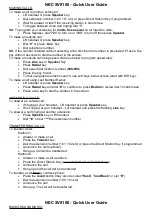
WaterMax RO Owner’s Manual
9/2020
12
Fact Section for Pentavalent Arsenic Treatment Appliances
Arsenic (As) is a naturally occurring contaminant found
in many ground waters. It generally occurs in two forms
(valences or oxidation states): pentavalent arsenic (also
known as As(V), As(+5), or arsenate) and trivalent
arsenic (also known as As(lll), As(+3), or arsenite). In
natural ground water, arsenic may exist as trivalent
arsenic, pentavalent arsenic, or a combination of both.
Although both forms of arsenic are potentially harmful
to human health, trivalent arsenic is considered more
harmful than pentavalent arsenic. More information
about arsenic and its toxicity can be found on the U.S.
Environmental Protection Agency Web site at
http://www.epa.gov/safewater/arsenic.html.
These appliances (Model Numbers; H6000 and H3500)
are designed to remove only pentavalent arsenic.
These appliances do not provide a feature for
conversion of trivalent arsenic to pentavalent arsenic.
The appliances may remove some trivalent arsenic;
however, they have not been evaluated to remove
trivalent arsenic.
Trivalent arsenic is generally more difficult to remove
from drinking water than pentavalent arsenic. Trivalent
arsenic can be converted to pentavalent arsenic in the
presence of an effective oxidant such as free chlorine.
The arsenic in water containing detectable free chlorine
or that has been treated with another effective oxidant
will be in the pentavalent arsenic form.¹ Treatment with
chloramines (combined chlorine) is not sufficient to
ensure complete conversion of trivalent arsenic to
pentavalent arsenic.
Consumers using public water supplies can contact
their utility to verify whether free chlorine treatment
chemicals are being used.
¹ Laboratory Study on the Oxidation of Arsenic lll to Arsenic V,
EPA/600/R-01/021, March 2001 available online at:
http://www.epa.gov/ORD/publications/ordpubs.html
Private water supplies and waters that do not have
detectable free chlorine residuals should be analyzed to
determine the form(s) of arsenic present and the
potential need for oxidation of trivalent arsenic to
pentavalent arsenic.
Arsenic does not generally impart color, taste, or smell
to water; therefore, it can only be detected by a
chemical analytical test. Public water supplies are
required to monitor treated water for total arsenic
(trivalent arsenic plus pentavalent arsenic) and the
results are available to the public from the utility.
Consumers using private water sources will need to
make arrangements for testing. A total arsenic test
usually costs about $15–$30, and it is recommended
the test be conducted by a certified laboratory. Local
health departments and environmental protection
agencies can help provide consumers with a list of
certified laboratories. Some laboratories may also be
able to analyze specifically for (speciate) the two forms
of arsenic present in a water sample if requested.
These appliances were tested under laboratory
conditions as defined in NSF/ANSI Standard 58
Reverse Osmosis Drinking Water Treatment appliance
and were found to reduce 0.30 mg/L in the test water to
less than 0.010 mg/L, under standard testing
conditions. Actual performance of the appliance may
vary depending on specific water quality conditions at
the consumer’s installation. Following installation of the
appliance, the consumer should have the treated water
tested for total arsenic to verify arsenic reduction is
being achieved and the appliance is functioning
properly.
The pentavalent arsenic removal component of these
appliances must be replaced at the end of its useful life
(approx. 3 years). The replacement component
#100236258 and #100236260 can be purchased from
the original source of this appliance (retailer or
distributor), from other sources of these appliances, or
directly from the manufacturer.
Hague Quality Water
4343 S. Hamilton Rd.
Groveport, OH 43125
Summary of Contents for WaterMax H3500
Page 42: ...Notes...
Page 43: ...2013 100338947 9 2020 Notes...













































